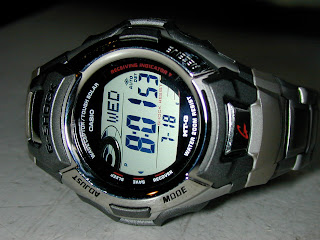
On one of Nilsen's Bund straps



The history of early aviation would not be complete without mentioning the aviator's chronograph. Early aircraft did not include much in the way of instrumentation but in order to properly navigate, however, accurate timekeeping was essential. One solution that was hit upon was the use of a
chronograph watch. Many well known companies produced watches for this purpose (Breitling probably being the most famous example). The Buran Chronograph falls into this category of watches as well.
The story of how this particular design came to be produced by Russia is historically interesting. Originally the precursor to this watch was manufactured in Germany (I believe by
Tutima using a
Urofa chronograph movement-see:
Reissue Issues). When WWII ended, the factory that produced this type of chronograph fell into Soviet hands. The Russians liked what they found and transported the assembly line back to Moscow. Production then began on a Russian version of the German chronograph which they called the Kirova (presumably named after Sergei
Kirov). The Buran Chronograph being reviewed here is one of two re-issues of that German designed watch. (A more historically correct version, appropriately called the
Kirova was produced along with the Buran (whose name means "Storm" I believe in Russian and may possibly be named after the Buran space shuttle). Irrespective of the name, however, the appearance of the models with their coin-edge bezels is unmistakably based on the old Tutima design. The re-issues do not use the Urofa movement however.
The Buran Chronograph has a matt finished stainless steel case that measures 40mm in width (not including the crown), 13mm in thickness, 52mm lug to lug, and has a 20mm band lug width. The crystal is made of mineral glass. (It should be noted that there is a smaller, 37mm version of this watch. If you are considering purchasing one of these, ensure that you get the right sized model.) The Buran's crown is particularly prominent and has the Poljot logo engraved on it. Internally, this re-issue is powered by a Poljot 3133 23 jewel hand wound movement. (The 3133 is based on the Swiss Valjoux
7734. The Russians bought this movement and its assembly line from the Swiss in the mid-seventies. Additionally, Poljot appears to have sold the tooling for the 3133 to another Russian company called Maktime . It is still being made and is widely used in Russian chronographs to this day.) The action of my example is very smooth and the 3133 has a long power reserve, generally in excess of 50 hours. The bezel on this Buran rotates freely in both directions (I have heard that on some versions of this watch the bezel is fixed) and the hands and numerals on the watch face appear to use superluminova lume which works quite well. In a pleasant surprise for a Russian watch, the Buran arrived on a leather band of reasonably good quality with a signed clasp. In terms of accuracy, my example seems to gain about 20 seconds a day. I can live with that but a jeweler might be able to improve the accuracy with regulation.
At one time, Russian watches were ridiculously affordable for what they delivered. That state of affairs has, sadly, ended. While it is still possible to find a good buy on the bay and elsewhere, there is no seriously denying that Russian watches, the chronographs in particular, have become very
pricey. While a Russian chronograph is still considerably more affordable than its Swiss counterparts, with prices commonly exceeding $400.00, they are no longer an impulse buy. As much as I miss seeing $100.00 Sturmanskies and the like, it really isn�t all that surprising that this market would eventually even out. With the ruble gaining strength on Russia�s oil revenues, there was really no other outcome. The example you see here was a fluke in my opinion. I recently acquired it, new in the box, for well under $180.00.
Like so many other Russian timepieces, the Buran Chronograph has the type of rich and interesting history that makes watch collecting so enjoyable to me. It is one of those pieces whose old-fashioned looks immediately remind me of its origins. In some ways, I find the process of learning about the history of a watch to be as enjoyable as actually acquiring a new piece for my collection. When it comes to having an interesting past, Russian watches rarely disappoint.
P.S.-If you are really interested in Russian watches, be sure to visit
Mark Gordon's excellent site. His collection is really remarkable




















































